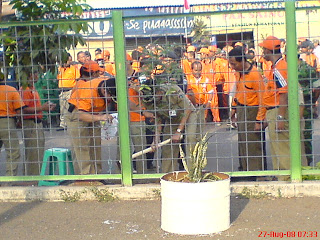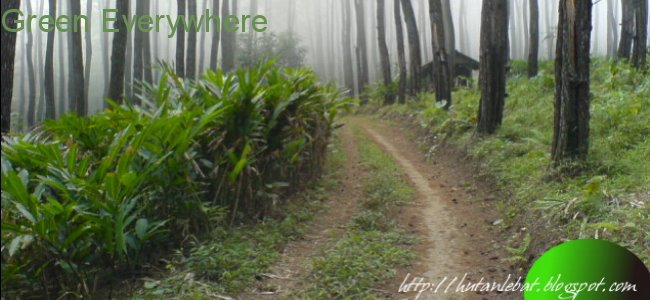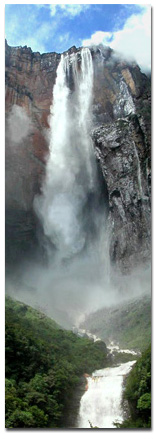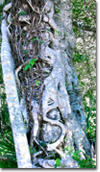
Probably no other distinct plant community has attracted as much curiosity and scientific attention for as long as have the mangrove forests. "Rollet's (1981) annotated bibliography lists 5,608 published titles through 1975 with one of the first being the written account from the chronicle of Nearchus, dating back to the Greek mariners of 325 BC." (S. C. Snedaker, University of Miami, Division of Marine Biology and Fisheries)
Living at the Edge of the Sea
"One perceives a forest of jagged, gnarled trees protruding from the surface of the sea, roots anchored in deep, black, foul-smelling mud, verdant crowns arching toward a blazing sun. . . . Here is where land and sea intertwine, where the line dividing ocean and continent blurs, in this setting the marine biologist and the forest ecologist both must work at the extreme reaches of their disciplines" ("Caribbean Mangrove Swamps", by Klause Rutzler and Ilka C. Feller, Scientific American, March 1996, p. 94)
Mangroves are the rainforests by the sea. "The majority of the subtropical and tropical coastline is dominated by mangroves, estimated to cover an area of 22 million hectares. However, over the past several decades, the global area in mangroves has increasingly diminished as a result of a variety of human activities, such as overharvesting, freshwater diversion and conversion to other uses." (Snedaker, University of Miami, personal correspondence)
Mangrove forests are comprised of taxonomically diverse, salt-tolerant tree and other plant species which thrive in intertidal zones of sheltered tropical shores, "overwash" islands, and estuaries. Mangrove trees have specially adapted aerial and salt-filtering roots and salt-excreting leaves that enable them to occupy the saline wetlands where other plant life cannot survive.
A Cornucopia of Life
Mangrove forests are vital for healthy coastal ecosystems. The forest detritus, consisting mainly of fallen leaves and branches from the mangroves, provides nutrients for the marine environment and supports immense varieties of sea life in intricate food webs associated directly through detritus or indirectly through the planktonic and epiphytic algal food chains. (Note: Plankton and benthic algae are primary sources of carbon in the mangrove ecosystem, in addition to detritus.)
The shallow intertidal reaches that characterize the mangrove wetlands offer refuge and nursery grounds for juvenile fish, crabs, shrimps, and mollusks. Mangroves are also prime nesting and migratory sites for hundreds of bird species. In Belize, for instance, there are over 500 species of birds recorded in mangrove areas. Additionally, manatees, crab-eating monkeys, fishing cats, monitor lizards, sea turtles, and mud-skipper fish utilize the mangrove wetlands.
The Origin of the Species
Scientists theorize that the earliest mangrove species originated in the Indo-Malayan region. This may account for the fact that there are far more mangrove species present in this region than anywhere else. Because of their unique floating propagules and seeds, certain of these early mangrove species spread westward, borne by ocean currents, to India and East Africa, and eastward to the Americas, arriving in Central and South America during the upper Cretaceous period and lower Miocene epoch, between 66 and 23 million years ago. During that time, mangroves spread throughout the Caribbean Sea across an open seaway which once existed where Panama lies today. Later, sea currents may have carried mangrove seeds to the western coast of Africa and as far south as New Zealand. This might explain why the mangroves of West Africa and the Americas contain fewer, but similar colonizing species, whereas those of Asia, India, and East Africa contain a much fuller range of mangrove species.
The Ecology of Mangroves
These complex ecosystems are found between the latitudes of 32 degrees north and 38 degrees south, along the tropical coasts of Africa, Australia, Asia, and the Americas. There are varying scientific classifications of what constitutes a mangrove plant. According to two reputable scientific studies, mangroves include approximately 16-24 families and 54-75 species (Tomlinson (1986) and Field (1995) respectively). The greatest diversity of mangrove species exists in Southeast Asia. For example, there are only twelve mangrove species in the New World and only four species of mangroves exist along portions of the coasts of the southern USA.
Mangrove forests literally live in two worlds at once, acting as the interface between land and sea. Mangroves help protect coastlines from erosion, storm damage, and wave action. The stability mangroves provide is of immense importance. They prevent shoreline erosion by acting as buffers and catch alluvial materials, thus stablizing land elevation by sediment accretion that balances sediment loss. Vital coral reefs and sea grass beds are also protected from damaging siltation.
A primary factor of the natural environment that affects mangroves over the long term is sea level and its fluctuations. Other shorter-term factors are air temperature, salinity, ocean currents, storms, shore slope, and soil substrate. Most mangroves live on muddy soils, but they also grow on sand, peat, and coral rock. If tidal conditions are optimal, mangroves can flourish far inland, along the upper reaches of coastal estuaries.
Mangroves vary in height according to species and environment, from mere shrubs to 40 meter trees. The prop roots of some mangrove species, such as Rhizophora or "red mangrove", and the pneumataphores of others, such as Avicennia or "black mangrove", contain many small "breathing" pores, called "lenticels." These allow oxygen to diffuse into the plant, and down to the underground roots by means of air space tissue in the cortex, called "aerenchyma." The lenticels are inactive during high tide.
Evolutionary adjustments to varying coastal marine environments have produced some astounding biological characteristics within mangrove plant communities. Certain species of mangroves exclude salt from their systems, others actually excrete the salt they take in via their leaves, roots, or branches. In salt excluding mangrove species , the mangrove root system is so effective in filtering out salt that a thirsty traveler could drink fresh water from a cut root, though the tree itself stands in saline soil.
Certain mangrove species can propagate successfully in a marine environment because of special adaptations. Through "viviparity," embryo germination begins on the tree itself; the tree later drops its developed embryos, called seedlings, which may take root in the soil beneath. Viviparity may have evolved as an adaptive mechanism to prepare the seedlings for long-distance dispersal, and survival and growth within a harsh saline environment. During this viviparous development, the propagules are nourished on the parent tree, thus accumulating the carbohydrates and other compounds required for later autonomous growth. The structural complexity achieved by the seedlings at this early stage of plant development helps acclimate the seedlings to extreme physical conditions which otherwise might preclude normal seed germination.
Another special adaptation is the dispersal of certain mangroves' "propagules" which hang from the branches of mature trees. These fall off and eventually take root in the soil surrounding the parent tree or are carried to distant shorelines. Depending on the species, these propagules may float for extended periods, up to a year, and still remain viable. Viviparity and the long-lived propagules allow these mangrove species to disperse over wide areas.
"Zonation" often characterizes mangrove forests. Certain tree species occupy particular areas, or niches, within the ecosystem. Some mangrove species occur close to shore, fringing islands and sheltered bays; others are found further inland, in estuaries influenced by tidal action.
The Importance for Local Communities
Mangrove ecosystems have traditionally been sustainably managed by local populations for the production of food, medicines, tannins, fuel wood, and construction materials. For millions of indigenous coastal residents, mangrove forests offer dependable, basic livelihoods and sustain their traditional cultures.
The protective mangrove buffer zone helps minimize damage of property and losses of life from hurricanes and storms. In regions where these coastal fringe forests have been cleared, tremendous problems of erosion and siltation have arisen, and sometimes terrible losses to human life and property have occurred due to destructive storms. Mangroves have also been useful in treating effluent, as the plants absorb excess nitrates and phosphates thereby preventing contamination of nearshore waters.
The Greatest Threats: an Ecosystem in Peril
Naturally resilient, mangrove forests have withstood severe storms and changing tides for many millennia, but they are now being devastated by modern encroachments. Today, mangrove forests are among the most threatened habitats in the world -- disappearing at an accelerating rate, yet with little public notice. Lenticels in the exposed portions of mangrove roots are highly susceptible to clogging by crude oil and other pollutants, attacks by parasites, and prolonged flooding from artificial dikes or causeways. Over time, environmental stress can kill large numbers of mangrove trees. In addition, the charcoal and timber industries have also severely impacted mangrove forests, as well as tourism and other coastal developments. The rapidly expanding shrimp aquaculture industry poses the gravest threat to the world's remaining mangroves. Literally thousands of hectares of lush mangrove forests have been cleared to make room for the artificial shrimp ponds of this boom and bust industry. This highly volatile enterprise has grown exponentially over the last 15 years, leaving devastating ruin in its wake.
Until recently, mangrove forests have been classified by many governments and industries alike as "wastelands", or useless swamps. This erroneous designation has made it easier to exploit mangrove forests as cheap and unprotected sources of land and water for shrimp farming. The amount of mangrove forest destruction is alarming. Thailand has lost more than half of its mangrove forests since 1960. In the Philippines, mangroves have declined from an estimated 448,000 hectares in the 1920s to only 110,000 hectares by 1990. In Ecuador, estimates of mangrove loss range from 20% percent to nearly one half of Ecuador's once 362,000 ha. of mangrove forested coastline. The Muisne region of Ecuador alone has lost nearly 90% percent of its mangroves. Globally, as much as 50% percent of mangrove destruction in recent years has been due to clear cutting for shrimp farms.
Towards Solutions: Protecting Mangrove Forests
The failure of national governments to adequately regulate the shrimp industry, and the headlong rush of multilateral lending agencies to fund aquaculture development without meeting their own stated ecological and social criteria, are other important pieces to this unfortunate puzzle. The fate of remaining mangrove forests may now rest in the hands of the consumers from the wealthy nations that import these luxury shrimp products. Since a highly profitable and expanding market is the driving force behind the shrimp industry, a worldwide reduction in consumer demand for pond-raised shrimp is called for.
Meanwhile, stricter local governmental regulations and enforcement protecting mangroves are necessary. Also, involvement of local communities in sustainably managing and protecting their coastal resource base, including the nearby mangrove forests, is essential.
References
* Baird, Ian, and Quarto, Alfredo, "The Environmental and Social Costs of Developing Coastal Shrimp Aquaculture in Asia", Earth Island Institute, 1994
* Chapman, V.J., "Mangrove Vegetation", J. Cramer, Germany, 1976
* Chapman, V.J., "Mangrove Biogeography", in Hydrobiology of the Mangal, The Ecosystem of the Mangrove Forest, the Hebrew University of Jerusalem, 1984
* Field, C.D. , "Journey Amongst Mangroves", International Society of Mangrove Ecosystems, Okinawa, Japan 1995, 140 pp.
* Hellier, C., "The Mangrove Wastelands", The Ecologist Journal, Vol. 18, No. 2, 1988
* Hong, Phan Nguyen, Hoang Thi San, "Mangroves of Vietnam", IUCN Wetlands Program, 1993
* Lugo, Ariel E., and S. C. Snedaker,1974 "The ecology of mangroves", Annual Review of Ecology and Systematics: 5:39-64
* Rutzler, Klaus, Feller, Ilka C., "Caribbean Mangrove Swamps", Scientific American, March 1996
* Saenger, P., Hegeri, E.J., and Macintosh, D.J., (eds), "Proceedings of the Asian Symposium on Mangrove Environment, Research and Management", Univ. of Malay, Kuala Lumpur, UNESCO, 1984
* Snedaker, S. C.,1993, "Impact on mangroves", pp. 282-305, In G.A. Maul (ed.) Climatic Change in the Intra-Americas Sea, Edward Arnold, Hodder and Sloughton Publishers, Kent, UK, 389 p.
* Tomlinson, P.B., "The Botany of Mangroves", Cambridge University Press, Cambridge, UK, 1986
 Garden in Train Station
Garden in Train Station















